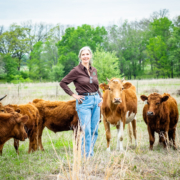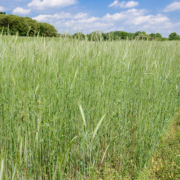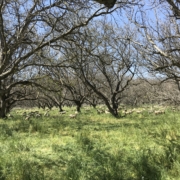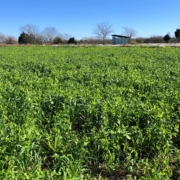Farmers and Ranchers Are Neither the Cause Nor the Solution to Climate Disruption
 Print This Post
Print This Post
By Jeff Schahczenski, NCAT Agricultural and Natural Resource Economist
“I have a lot of emotions, a lot of anxiety and some depression because I don’t see myself doing it like we have always done it,” said Megan, who is the sixth generation to run the ranch. “For me it was like, ‘I can’t mess this up. They’ve set my path for me. If I just follow what they’ve been doing, I’ll be fine.’ It’s not like that anymore. I have to change if I want to stay in this business. And I’m realizing that and it’s terrifying.”
—Megan Brown, Northern California Rancher, as reported by the National Farmers Union in Facing the Constant Threat of Climate Change, Farmers Cope with Grief and Stress
The anxiety and stress farmers and ranchers face because of the consequence of climate disruption are real, but neither the causes nor significant solutions rest with farmers and ranchers.
According to the report Climate Change 2022: Mitigation of Climate Change, from the Intergovernmental Panel on Climate Change (IPCC), the level of net greenhouse gas emissions (GHG) in 2019 was estimated to be 59 gigatons of carbon dioxide equivalent. A gigaton is a billion metric tons. That is a lot of extra climate-disrupting gases being released into the atmosphere of our planet every year. Unfortunately, those emissions levels are growing.
It also should be of little surprise that since the dawn of the Industrial Revolution, as we’ve become dependent on the burning of fossil fuels, that such releases would ultimately wreak havoc on our planet. We are simply addicted to the benefits that fossil fuels have provided many of us. It is very difficult to even contemplate how to live in a world without fossil fuels. The very plastic computer upon which I am writing this blog would not exist without petroleum.

Healthy soil. Photo: Mike Morris, NCAT
As of late, there has been expanding interest in the role agriculture can play in both mitigating GHG emissions and removing and stabilizing carbon in healthier soils. There also has not been such a clamoring for carbon markets since the failure of the American Clean Energy and Security Act 2009. The blossoming of agriculture carbon schemes—not really a market yet—is as prolific and haphazard as the daffodils springing up in my daughter’s yard this spring.
Unfortunately, while there is room for improvement in the way farming and ranching is done to both mitigate GHG emissions and sequester carbon by improving soil health, agriculture’s contribution to such efforts is limited. This is a critical point, which is also fundamental to the recent IPCC report and so often overlooked by the proponents of agriculture carbon markets.
The report also verified that world agriculture has only a limited role to play in solutions to future climate disruption. As the report states, the largest economic potential and climate benefits from agriculture derive from:
“Improved and sustainable crop and livestock management, and carbon sequestration in agriculture, the latter includes soil carbon management in croplands and grasslands, agroforestry, and biochar, can contribute 1.8-4.1 GtCO2-eq yr-1 reduction.”
So, taking the upper range of this estimate for improving sustainable crop and livestock management and carbon sequestration in agriculture, world agriculture can possibly, at best, alleviate 7% of the current total 59 gigatons of carbon dioxide equivalent released in 2019. Bottom line: agriculture is neither the major cause nor the remedy for climate disruption.
However, the real challenge will be to lower that 7% to, say, 3% and that is a possibility IF we move quickly to resilient organic and other sustainable systems of production. This is no easy task, but the opportunity is before us, and our grandchildren deserve our best efforts.
Related ATTRA Resources:
Agriculture, Climate Disruption, and Carbon Sequestration
Biochar and Sustainable Agriculture
Managing Soils for Water: How Five Principles of Soil Health Support Water Infiltration and Storage
Climate Change and Perennial Fruit and Nut Production: Investing in Resilience in Uncertain Times
This blog is produced by the National Center for Appropriate Technology through the ATTRA Sustainable Agriculture program, under a cooperative agreement with USDA Rural Development. ATTRA.NCAT.ORG.







 Courtesy Montana Department of Commerce
Courtesy Montana Department of Commerce



